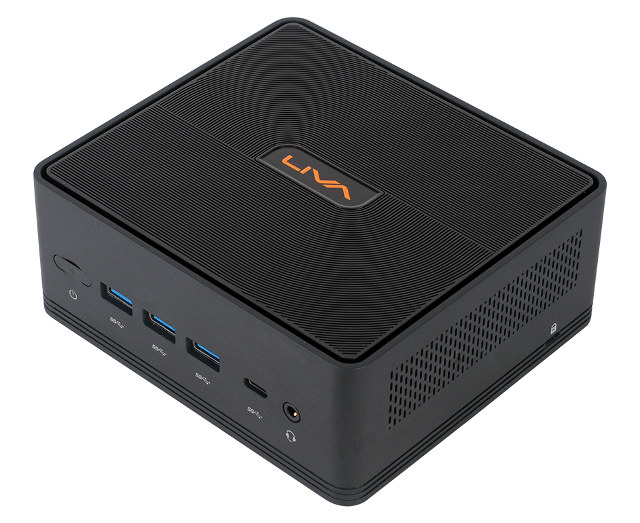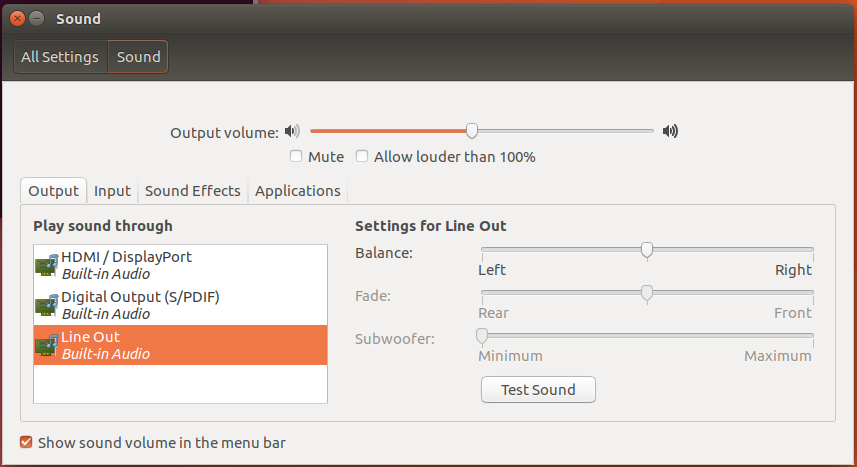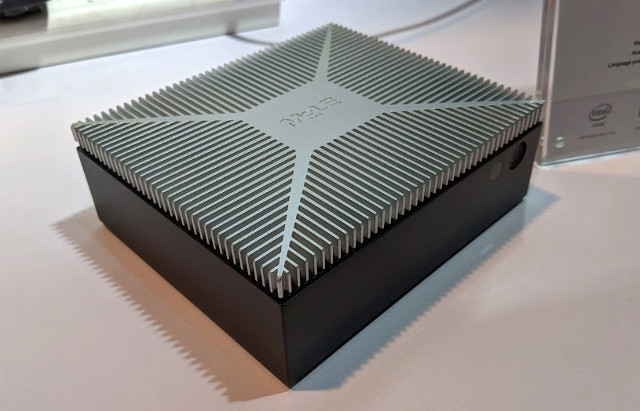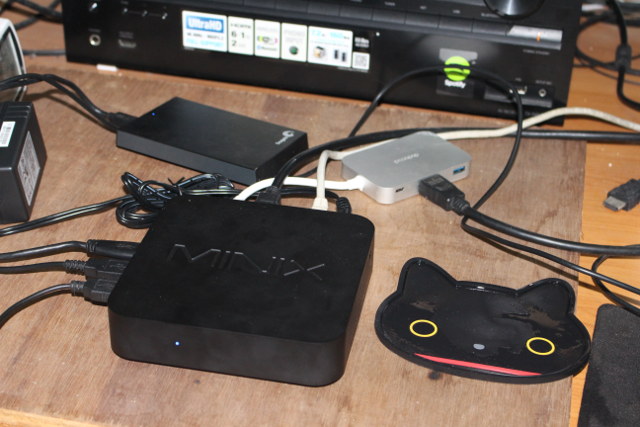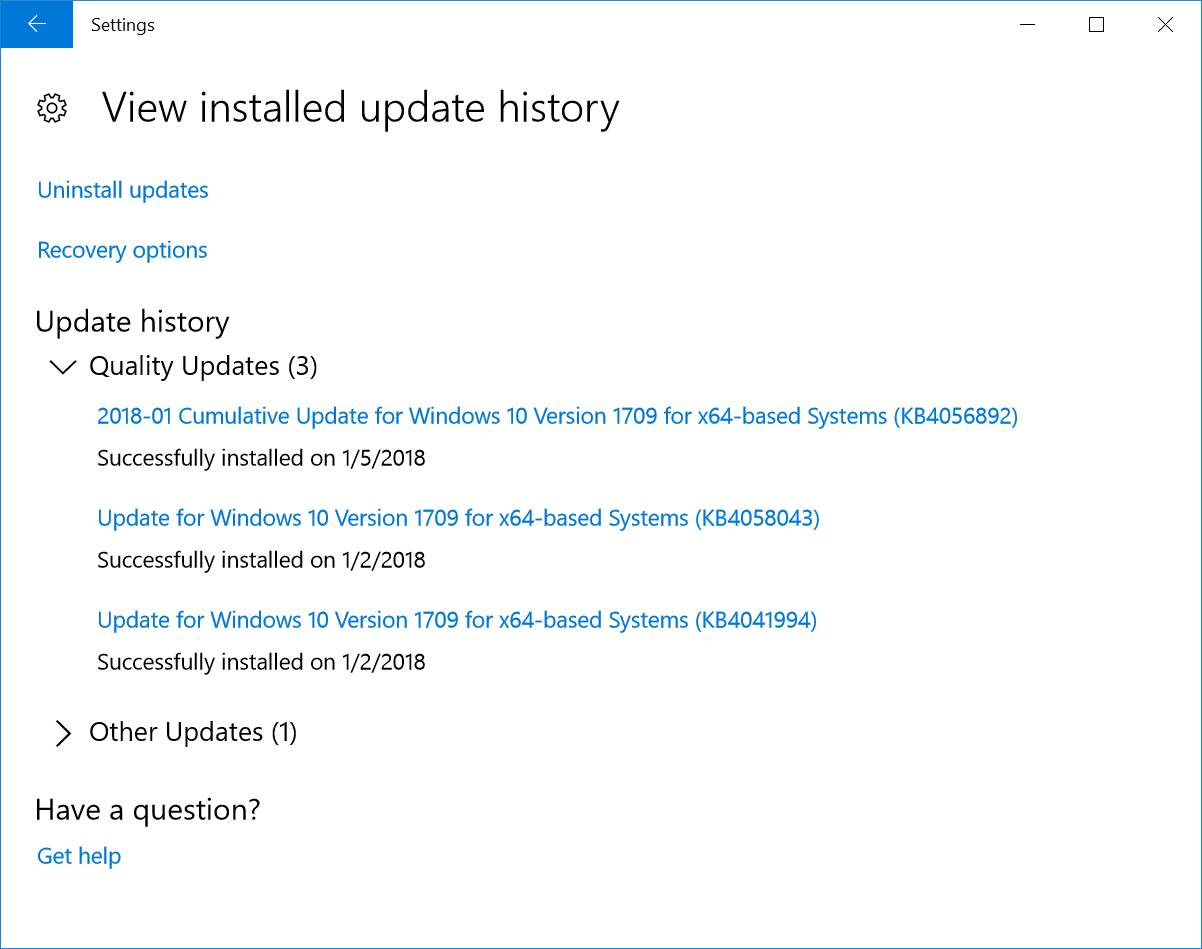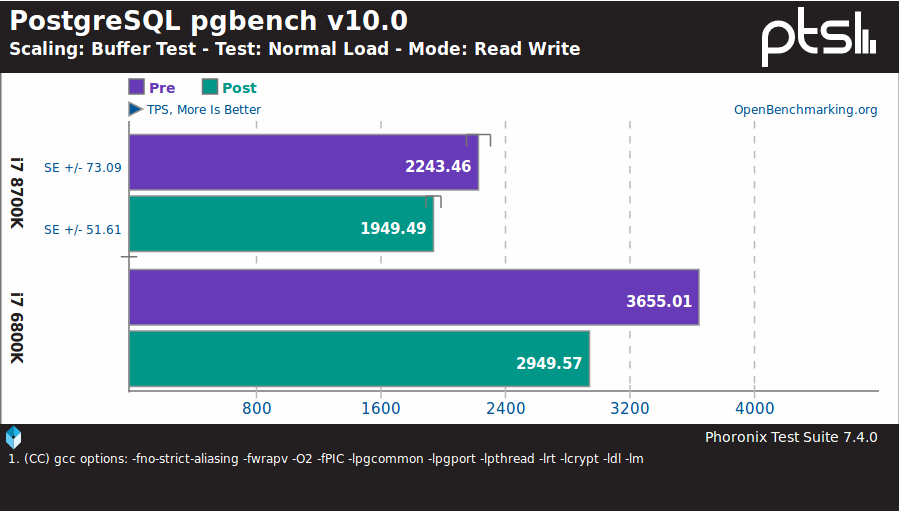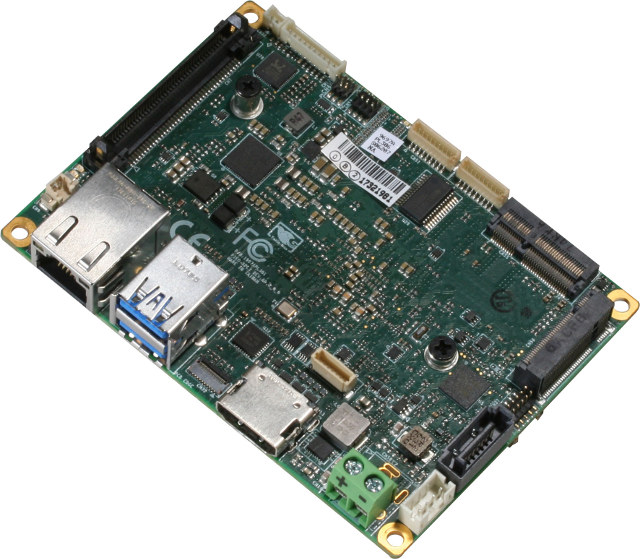ECS (Elitegroup Computer Systems) was another company introducing their Gemini Lake mini PC at CES 2018, or as they call them “ultra-compact form-factor” (UCFF) PCs. They had three models with two upgrade from Apollo Lake systems: LIVA Z2 & LIVA Q2, and another system called “LIVA One SoC” which instead offers an entry-level version of their barebone LIVA One mini PC based on Core i3/i5/i7 processors. ECS LIVA Z2 LIVA Z2 specifications: SoC – Intel Gemini Lake processor System Memory – 2x DDR4 SO-DIMM slots Storage – 32 or 64GB eMMC flash, 1x 2.5″ SSD/HDD bay Video Output – HDMI 2.0 and HDMI 1.4 ports (dual HDMI) Audio Output – Via HDMI, 3.5mm audio jack, digital microphone Connectivity – Gigabit Ethernet, 802.11ac WiFi, Bluetooth 4.2 USB – 3x USB 3.0 ports, 2x USB 2.0 ports, 1x USB 3.0 type C port Misc – Power button, Kensington lock Power Supply – 19V/3.42A […]
MINIX NEO N42C-4 Pro Review – Part 3: Ubuntu / Linux
In the second part of MINIX NEO N42C-4 review (and on linuxium website), we looked at the device and the performance using Windows. In this third part, we will look at how to install and the performance of using Linux (Ubuntu). The BIOS does not include an option to select Linux as a boot OS and a standard Ubuntu ISO written to a USB will not boot. So to install Ubuntu to the eMMC as dual-boot first it was necessary to respin a standard Ubuntu ISO using my ‘isorespin.sh’ script with the ‘–apollo’ option, and which after creating a LiveUSB using the ‘dd’ command was used to boot and install Ubuntu. First let’s remind ourselves of the hardware configuration by running some standard Linux commands:
|
1 2 3 4 5 6 7 8 9 10 11 12 13 14 15 16 17 18 19 20 21 22 23 24 25 26 27 28 29 30 31 32 33 34 35 36 37 38 39 40 41 42 43 44 45 46 47 48 49 50 51 52 53 54 55 56 57 58 59 60 61 62 63 64 65 66 67 68 69 70 71 72 73 74 75 76 77 78 79 80 81 82 83 84 85 86 87 88 89 90 91 92 93 94 95 96 97 98 99 100 101 102 103 104 105 106 107 108 109 110 111 112 113 114 115 116 117 118 119 120 121 122 123 124 125 126 127 128 129 130 131 132 133 134 135 136 137 138 139 140 141 142 143 144 145 146 147 148 149 150 151 152 153 154 155 156 157 158 159 160 161 162 163 164 165 166 167 168 169 170 171 172 173 174 175 176 177 178 179 180 181 182 183 184 185 186 187 188 189 190 191 192 193 194 195 196 |
linuxium@N42C-4:~$ lsb_release -a Distributor ID: Ubuntu Description: Ubuntu 17.04 Release: 17.04 Codename: zesty linuxium@N42C-4:~$ linuxium@N42C-4:~$ uname -a Linux N42C-4 4.10.0-19-generic #21-Ubuntu SMP Thu Apr 6 17:04:57 UTC 2017 x86_64 x86_64 x86_64 GNU/Linux linuxium@N42C-4:~$ linuxium@N42C-4:~$ inxi -Fc0 System: Host: N42C-4 Kernel: 4.10.0-19-generic x86_64 (64 bit) Desktop: N/A Distro: Ubuntu 17.04 Machine: Device: desktop Mobo: MINIX model: N42C-4 v: Default string serial: Default string UEFI: American Megatrends v: 5.12 date: 11/14/2017 CPU: Quad core Intel Pentium N4200 (-MCP-) cache: 1024 KB clock speeds: max: 2500 MHz 1: 897 MHz 2: 2394 MHz 3: 1333 MHz 4: 2319 MHz Graphics: Card: Intel Celeron N3350/Pentium N4200/Atom E3900 Series Integrated Graphics Controller Display Server: X.org 1.19.3 drivers: modesetting (unloaded: fbdev,vesa) tty size: 204x62 Advanced Data: N/A for root Audio: Card Intel Celeron N3350/Pentium N4200/Atom E3900 Series Audio Cluster driver: snd_hda_intel Sound: Advanced Linux Sound Architecture v: k4.10.0-19-generic Network: Card-1: Realtek RTL8111/8168/8411 PCI Express Gigabit Ethernet Controller driver: r8169 IF: enp1s0 state: up speed: 1000 Mbps duplex: full mac: a0:1e:0b:09:64:59 Card-2: Intel Device 24fb driver: iwlwifi IF: wlp2s0 state: down mac: 5e:8e:91:6c:84:80 Drives: HDD Total Size: NA (-) ID-1: /dev/mmcblk0 model: N/A size: 31.3GB Partition: ID-1: / size: 9.8G used: 5.8G (62%) fs: ext4 dev: /dev/mmcblk0p5 RAID: No RAID devices: /proc/mdstat, md_mod kernel module present Sensors: System Temperatures: cpu: 47.0C mobo: N/A Fan Speeds (in rpm): cpu: N/A Info: Processes: 212 Uptime: 7 min Memory: 633.4/3796.5MB Client: Shell (review-tests.sh) inxi: 2.3.8 linuxium@N42C-4:~$ linuxium@N42C-4:~$ df -h Filesystem Size Used Avail Use% Mounted on udev 1.9G 0 1.9G 0% /dev tmpfs 380M 6.3M 374M 2% /run /dev/mmcblk0p5 9.8G 5.8G 3.6G 62% / tmpfs 1.9G 12K 1.9G 1% /dev/shm tmpfs 5.0M 4.0K 5.0M 1% /run/lock tmpfs 1.9G 0 1.9G 0% /sys/fs/cgroup /dev/mmcblk0p2 96M 74M 23M 77% /boot/efi tmpfs 380M 172K 380M 1% /run/user/1000 /dev/mmcblk0p4 19G 17G 2.1G 90% /media/linuxium/309476E59476ACCA tmpfs 380M 0 380M 0% /run/user/0 linuxium@N42C-4:~$ linuxium@N42C-4:~$ lsblk -a NAME MAJ:MIN RM SIZE RO TYPE MOUNTPOINT loop0 7:0 0 0 loop loop1 7:1 0 0 loop loop2 7:2 0 0 loop loop3 7:3 0 0 loop loop4 7:4 0 0 loop loop5 7:5 0 0 loop loop6 7:6 0 0 loop loop7 7:7 0 0 loop mmcblk0 179:0 0 29.1G 0 disk ├─mmcblk0p1 179:1 0 499M 0 part ├─mmcblk0p2 179:2 0 100M 0 part /boot/efi ├─mmcblk0p3 179:3 0 16M 0 part ├─mmcblk0p4 179:4 0 18.5G 0 part /media/linuxium/309476E59476ACCA └─mmcblk0p5 179:5 0 10G 0 part / mmcblk0boot0 179:8 0 4M 1 disk mmcblk0boot1 179:16 0 4M 1 disk mmcblk0rpmb 179:24 0 4M 0 disk linuxium@N42C-4:~$ linuxium@N42C-4:~$ sudo lshw -C cpu *-cpu description: CPU product: Intel(R) Pentium(R) CPU N4200 @ 1.10GHz vendor: Intel Corp. physical id: 34 bus info: cpu@0 version: Intel(R) Pentium(R) CPU N4200 @ 1.10GHz slot: SOCKET 0 size: 2399MHz capacity: 2500MHz width: 64 bits clock: 100MHz capabilities: x86-64 fpu fpu_exception wp vme de pse tsc msr pae mce cx8 apic sep mtrr pge mca cmov pat pse36 clflush dts acpi mmx fxsr sse sse2 ss ht tm pbe syscall nx pdpe1gb rdtscp constant_tsc art arch_perfmon pebs bts rep_good nopl xtopology tsc_reliable nonstop_tsc aperfmperf tsc_known_freq pni pclmulqdq dtes64 monitor ds_cpl vmx est tm2 ssse3 sdbg cx16 xtpr pdcm sse4_1 sse4_2 x2apic movbe popcnt tsc_deadline_timer aes xsave rdrand lahf_lm 3dnowprefetch cat_l2 intel_pt tpr_shadow vnmi flexpriority ept vpid fsgsbase tsc_adjust smep erms mpx rdt_a rdseed smap clflushopt sha_ni xsaveopt xsavec xgetbv1 xsaves dtherm ida arat pln pts cpufreq configuration: cores=4 enabledcores=4 threads=4 linuxium@N42C-4:~$ linuxium@N42C-4:~$ sudo lshw -C memory *-firmware description: BIOS vendor: American Megatrends Inc. physical id: 0 version: 5.12 date: 11/14/2017 size: 64KiB capacity: 5056KiB capabilities: pci upgrade shadowing cdboot bootselect socketedrom edd int13floppy1200 int13floppy720 int13floppy2880 int5printscreen int9keyboard int14serial int17printer acpi usb biosbootspecification uefi *-memory description: System Memory physical id: 2e slot: System board or motherboard size: 4GiB *-bank:0 description: SODIMM DDR3 Synchronous 1600 MHz (0.6 ns) product: M471B5173EB0-YK0 vendor: Samsung physical id: 0 serial: 96537C8F slot: ChannelA-DIMM0 size: 4GiB width: 64 bits clock: 1600MHz (0.6ns) *-bank:1 description: DIMMProject-Id-Version: lshwReport-Msgid-Bugs-To: FULL NAME <EMAIL@ADDRESS>POT-Creation-Date: 2009-10-08 14:02+0200PO-Revision-Date: 2012-02-02 13:04+0000Last-Translator: Joel Addison <jaddi27@gmail.com>Language-Team: English (Australia) <en_AU@li.org>MIME-Version: 1.0Content-Type: text/plain; charset=UTF-8Content-Transfer-Encoding: 8bitX-Launchpad-Export-Date: 2017-04-04 11:54+0000X-Generator: Launchpad (build 18335) [empty] physical id: 1 slot: ChannelB-DIMM0 *-cache:0 description: L1 cache physical id: 32 slot: CPU Internal L1 size: 224KiB capacity: 224KiB capabilities: synchronous internal write-back configuration: level=1 *-cache:1 description: L2 cache physical id: 33 slot: CPU Internal L2 size: 2MiB capacity: 2MiB capabilities: synchronous internal write-back unified configuration: level=2 linuxium@N42C-4:~$ linuxium@N42C-4:~$ free -mh total used free shared buff/cache available Mem: 3.7G 573M 2.4G 158M 744M 2.8G Swap: 472M 0B 472M linuxium@N42C-4:~$ linuxium@N42C-4:~$ sudo lshw -C network *-network description: Ethernet interface product: RTL8111/8168/8411 PCI Express Gigabit Ethernet Controller vendor: Realtek Semiconductor Co., Ltd. physical id: 0 bus info: pci@0000:01:00.0 logical name: enp1s0 version: 07 serial: a0:1e:0b:09:64:59 size: 1Gbit/s capacity: 1Gbit/s width: 64 bits clock: 33MHz capabilities: pm msi pciexpress msix vpd bus_master cap_list ethernet physical tp mii 10bt 10bt-fd 100bt 100bt-fd 1000bt 1000bt-fd autonegotiation configuration: autonegotiation=on broadcast=yes driver=r8169 driverversion=2.3LK-NAPI duplex=full firmware=rtl8168e-3_0.0.4 03/27/12 ip=XXX.XXX.XXX.XXX latency=0 link=yes multicast=yes port=MII speed=1Gbit/s resources: irq:369 ioport:e000(size=256) memory:a1200000-a1200fff memory:c0000000-c0003fff *-network description: Wireless interface product: Intel Corporation vendor: Intel Corporation physical id: 0 bus info: pci@0000:02:00.0 logical name: wlp2s0 version: 10 serial: 5e:8e:91:6c:84:80 width: 64 bits clock: 33MHz capabilities: pm msi pciexpress bus_master cap_list ethernet physical wireless configuration: broadcast=yes driver=iwlwifi driverversion=4.10.0-19-generic firmware=22.361476.0 latency=0 link=no multicast=yes wireless=IEEE 802.11 resources: irq:373 memory:a1100000-a1101fff linuxium@N42C-4:~$ linuxium@N42C-4:~$ dmesg | grep "MMC card" [ 2.456272] mmc0: new HS400 MMC card at address 0001 linuxium@N42C-4:~$ linuxium@N42C-4:~$ lsusb Bus 002 Device 001: ID 1d6b:0003 Linux Foundation 3.0 root hub Bus 001 Device 003: ID 8087:0aa7 Intel Corp. Bus 001 Device 005: ID 046d:c52b Logitech, Inc. Unifying Receiver Bus 001 Device 004: ID 10d5:55a4 Uni Class Technology Co., Ltd Bus 001 Device 002: ID 1a40:0101 Terminus Technology Inc. Hub Bus 001 Device 001: ID 1d6b:0002 Linux Foundation 2.0 root hub linuxium@N42C-4:~$ linuxium@N42C-4:~$ lspci 00:00.0 Host bridge: Intel Corporation Celeron N3350/Pentium N4200/Atom E3900 Series Host Bridge (rev 0b) 00:02.0 VGA compatible controller: Intel Corporation Celeron N3350/Pentium N4200/Atom E3900 Series Integrated Graphics Controller (rev 0b) 00:0e.0 Audio device: Intel Corporation Celeron N3350/Pentium N4200/Atom E3900 Series Audio Cluster (rev 0b) 00:0f.0 Communication controller: Intel Corporation Celeron N3350/Pentium N4200/Atom E3900 Series Trusted Execution Engine (rev 0b) 00:12.0 SATA controller: Intel Corporation Celeron N3350/Pentium N4200/Atom E3900 Series SATA AHCI Controller (rev 0b) 00:13.0 PCI bridge: Intel Corporation Celeron N3350/Pentium N4200/Atom E3900 Series PCI Express Port A #2 (rev fb) 00:13.2 PCI bridge: Intel Corporation Celeron N3350/Pentium N4200/Atom E3900 Series PCI Express Port A #3 (rev fb) 00:15.0 USB controller: Intel Corporation Celeron N3350/Pentium N4200/Atom E3900 Series USB xHCI (rev 0b) 00:1c.0 SD Host controller: Intel Corporation Celeron N3350/Pentium N4200/Atom E3900 Series eMMC Controller (rev 0b) 00:1f.0 ISA bridge: Intel Corporation Celeron N3350/Pentium N4200/Atom E3900 Series Low Pin Count Interface (rev 0b) 00:1f.1 SMBus: Intel Corporation Celeron N3350/Pentium N4200/Atom E3900 Series SMBus Controller (rev 0b) 01:00.0 Ethernet controller: Realtek Semiconductor Co., Ltd. RTL8111/8168/8411 PCI Express Gigabit Ethernet Controller (rev 07) 02:00.0 Network controller: Intel Corporation Device 24fb (rev 10) linuxium@N42C-4:~$ |
This shows the memory will be dual-channel once the second slot (bank:1) is populated and also confirms that the eMMC 5.1 (mmc0) is running […]
MeLE PCG63-APL4 Fanless Gemini Lake Mini PC To Launch in Q2 2018
Gemini Lake mini PCs are being announced at CES 2018, and we can expect them to sell in Q2 2018 for a price similar to Apollo Lake models all other features being equal. We’ve already seen ZOTAC ZBOX PI226 & PI336, ASUS unveiled their PN40 mini PC with few details, and of course Intel’s own GLK NUCs should be brought to market soon enough. MeLE has made some decent Apollo Lake mini PCs in the past year with their PCG35 Apo and PCG03 Apo models, so it’s no surprise the company is now showcasing their upcoming PCG63-APL4 based on Gemini Lake processors at CES 2018.MeLE PCG63-APL4 specifications: SoC (one or the other) Intel Celeron J4005 dual core Gemini Lake processor up to 2.0/2.7 GHz with 12EU Intel UHD Graphics 600 @ up to 700 MHz; 10W TDP Intel Celeron J4105 quad core Gemini Lake processor up to 1.5/2.5 GHz with […]
MINIX NEO N42C-4 Mini PC Review – Part 2: Windows 10 Pro
MINIX NEO N42C-4 is the first Apollo Lake mini PC from the company, which also happens to be their first one with a fan, using internal antennas for WiFi and Bluetooth, and offering user-upgradeable storage and memory thanks to M.2 and SO-DIMM slots. The device also features three video output via HDMI 2.0, mini DiplayPort, and USB Type C ports supporting up to three independent display. I’ve received a sample and already checked the hardware, and showed how to install an M.2 SSD and SO-DIMM RAM to the device in the first part of the review entitled MINIX NEO N42C-4 Triple Display Capable Mini PC Review – Part 1: Unboxing and Teardown, so I’ll report my experience with Windows 10 Pro in the second part of the review, and there should also be a third part specifically dealing with Linux support. MINIX NEO N42C-4 Setup, System Info, BIOS The device […]
Intel Apollo Lake Windows 10 Benchmarks Before and After Meltdown & Spectre Security Update
So this week, there’s been a fair amount of news about Meltdown & Spectre exploits, which affects all major processor vendors one way or another, but especially Intel, and whose mitigations require operating systems and in some case microcode updates that decrease performance for some specific tasks. Microsoft has now pushed an update for Windows 10, and since I’m reviewing MINIX NEO N42C-4 mini PC powered by an Intel Pentium N4200 “Apollo Lake” processor, and just happened to run benchmarks before the update, so I decided to run some of the benchmarks again to see if there was any significant difference before and after the security update. First I had to verify I had indeed received the update in the “installed update history”, and Windows 10 Pro was updated on January 5th with KB4056892, which is what we want, so let’s go ahead. Benchmarks before Update PCMark 10 is one […]
Companies Address Concerns related to Speculative Execution Exploits: Meltdown and Spectre
Yesterday, news surfaced about a “bug” in Intel processors that could be fixed at the operating system level at the cost of a decrease in performance for some tasks, from a typical, and barely noticeable 5% hit, to a more consequent 30% hit for some specific tasks, and as we discussed yesterday I/O intensive tasks are the most impacted by the changes. While Intel (and Arm) are impacted, AMD claims not to be, and the issue was reported by major news outlets and likely impacting the stock price of the companies with Intel stock losing 3.39%, and AMD stock gaining 5.19%, so obviously every company felt the need to answer, starting with Intel’s response to security research findings: Recent reports that these exploits are caused by a “bug” or a “flaw” and are unique to Intel products are incorrect. Based on the analysis to date, many types of computing devices […]
Intel Hardware Security Bug Fix to Hit Performance on Windows, Linux…
Many security bugs can be fixed without performance penalty , but according to reports Intel processors have a hardware bug – whose details have not been disclosed yet (embargo) – that seems to affect all operating systems including Windows, Linux, Mac OS, etc…, and the fix may lead to significant performance hits for some tasks. We know a bit more thanks to the Kernel Page Table Isolation (KPTI) patch for Linux that enables the fix/workaround with X86_BUG_CPU_INSECURE feature. The fix used to be called KAISER, and there’s an explanation on LWN about “hiding the kernel from user space” about the issue: On contemporary 64-bit systems, the shared address space does not constrain the amount of virtual memory that can be addressed as it used to, but there is another problem that is related to security. An important technique for hardening the system is kernel address-space layout randomization (KASLR), which randomizes […]
PICO-APL3 Apollo Lake Pico-ITX Board Comes with an Optional TPM 2.0 Module
AAEON has launched another industrial Pico-ITX board powered by Intel Celeron/Pentium Apollo Lake processors with their PICO-APL3 Pico-ITX single board computer featuring either Celeron N3350 or Pentium N4200 processor together with 2 to 4GB soldered DDR3L memory, and 16 to 64 GB eMMC flash. The company explains that one of key differences against other similar board is the option for a TPM module / hardware security that would allow applications such as payment processing for retailers or on the go. AAEON PICO-APL3 board specifications: SoC Intel Celeron N3350 dual core Apollo Lake processor @ up to 1.10/2.40GHz with 12EU Intel HD Graphics 500; 6W TDP Intel Pentium N4200 quad core Apollo Lake processor @ up to 1.10/2.50GHz with 18 EU Intel HD Graphics 505; 6W TDP System Memory – 2GB DDR3L on-board (Option to 4GB) Storage – 16GB eMMC flash (32/64 GB as option), 1x SATA III port (5V/12V power), […]


